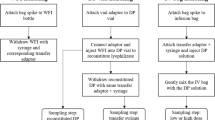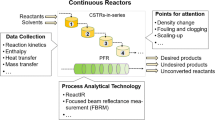Abstract
The use of an aqueous-based surrogate solution in at-scale process development for biopharmaceutical drug products enables significant reduction in the usage of costly drug substance and improves confidence in initial drug product production runs performed using active biotherapeutic. Strategies for the formulation design of a surrogate solution that is representative of the unit operations in a typical drug product manufacturing process for a biopharmaceutical are presented herein, and a case study for the development of a surrogate solution for an example protein drug product is discussed. The surrogate was shown to have similar physical attributes to the drug product, including viscosity, surface tension, and density. The surrogate was used in at-scale process development of compounding, filling, and lyophilization operations in a single technical run, and the performance was shown to be similar to that of the drug product solution, providing a cost-effective and readily available option for process development while minimizing operator exposure to potentially hazardous drug solution and limiting drug wastage.




Similar content being viewed by others
Change history
10 February 2021
A Correction to this paper has been published: https://doi.org/10.1208/s12249-021-01935-w
References
Rayaprolu BM, Strawser JJ, Anyarambhatla G. Excipients in parenteral formulations: selection considerations and effective utilization with small molecules and biologics. Drug Dev Ind Pharm. 2018;44(10):1565–71. https://doi.org/10.1080/03639045.2018.1483392.
Shieu W, Torhan SA, Chan E, Hubbard A, Gikanga B, Stauch OB, et al. Filling of high-concentration monoclonal antibody formulations into pre-filled syringes: filling parameter investigation and optimization. PDA J Pharm Sci Technol. 2014;68(2):153–63. https://doi.org/10.5731/pdajpst.2014.00973.
Nail SL, Searles JA. Elements of quality by design in development and scale-up of freeze-dried parenterals. BioPharm Int. 2008;21(1):44–52.
Rathore N, Rajan RS. Current perspectives on stability of protein drug products during formulation, fill and finish operations. Biotechnol Prog. 2008;24(3):504–14. https://doi.org/10.js980445/bp070462h.
Bird RB, Stewart WE, Lightfoot EN. Transport Phenomena. Chapter 9, Thermal conductivity and the mechanisms of energy transport: Wiley; 1960. p. 268–89. https://doi.org/10.1021/ed038pA640.
Grenville RK, Nienow AW. Blending of miscible liquids. In: Handbook of industrial mixing: Wiley. p. 507–42. https://doi.org/10.1002/0471451452.ch9.
Pfitzner J, Poiseuille JL. Poiseuille and his law. Anaesthesia. 1976;31(2):273–5. https://doi.org/10.1111/j.1365-2044.1976.tb11804.x.
Sethuraman A, Pan X, Mehta B, Radhakrishnan V. Filling processes and technologies for liquid biopharmaceuticals. In: Formulation and process development strategies for biopharmaceuticals: Wiley; 2010. p. 839–56. https://doi.org/10.1002/9780470595886.ch33.
Concetto G. Measurement of surface tension by the dripping from a needle. Phys Educ. 2006;41(5):440–4. https://doi.org/10.1088/0031-9120/41/5/010.
Searles JA, Carpenter JF, Randolph TW. The ice nucleation temperature determines the primary drying rate of lyophilization for samples frozen on a temperature-controlled shelf. J Pharm Sci. 2001;90(7):860–71. https://doi.org/10.1002/jps.1039.
Overcashier DE, Patapoff TW, Hsu CC. Lyophilization of protein formulations in vials: investigation of the relationship between resistance to vapor flow during primary drying and small-scale product collapse. J Pharm Sci. 1999;88(7):688–95. https://doi.org/10.js980445/js980445+.
Jameel F, Searles J. Development and optimization of the freeze-drying processes. In: Formulation and process development strategies for biopharmaceuticals: Wiley; 2010. p. 763–96. https://doi.org/10.1002/9780470595886.ch30.
Zidar M, Rozman P, Belko-Parkel K, Ravnik M. Control of viscosity in biopharmaceutical protein formulations. J Colloid Interface Sci. 2020;580:308–17. https://doi.org/10.1016/j.jcis.2020.06.105.
Amrhein S, Bauer KC, Galm L, Hubbuch J. Non-invasive high throughput approach for protein hydrophobicity determination based on surface tension. Biotechnol Bioeng. 2015;112(12):2485–94. https://doi.org/10.1002/bit.25677.
Absolom DR, Zingg W, Neumann AW. Protein adsorption to polymer particles: role of surface properties. J Biomed Mater Res. 1987;21(2):161–71. https://doi.org/10.1002/jbm.820210202.
Bull HB, Breese K. Surface tension of amino acid solutions: a hydrophobicity scale of the amino acid residues. Arch Biochem Biophys. 1974;161(2):665–70. https://doi.org/10.1016/0003-9861(74)90352-x.
Kato A, Nakai S. Hydrophobicity determined by a fluorescence probe method and its correlation with surface properties of proteins. Biochim Biophys Acta. 1980;624(1):13–20. https://doi.org/10.1016/0005-2795(80)90220-2.
Keshavarz E, Nakai S. The relationship between hydrophobicity and interfacial tension of proteins. Biochim Biophys Acta. 1979;576(2):269–79. https://doi.org/10.1016/0005-2795(79)90402-1.
Depaz RA, Pansare S, Patel SM. Freeze-drying above the glass transition temperature in amorphous protein formulations while maintaining product quality and improving process efficiency. J Pharm Sci. 2016;105(1):40–9. https://doi.org/10.1002/jps.24705.
Gearing J, Malik KP, Matejtschuk P. Use of dynamic mechanical analysis (DMA) to determine critical transition temperatures in frozen biomaterials intended for lyophilization. Cryobiology. 2010;61(1):27–32. https://doi.org/10.1016/j.cryobiol.2010.04.002.
Wang W. Lyophilization and development of solid protein pharmaceuticals. Int J Pharm. 2000;203(1–2):1–60. https://doi.org/10.1016/s0378-5173(00)00423-3.
Yalkowski S, He Y, Jain P. Handbook of aqueous solubility data. 2nd ed. Boca Raton: CRC Press; 2010. https://doi.org/10.1201/9780203490396.
Her LM, Nail SL. Measurement of glass transition temperatures of freeze-concentrated solutes by differential scanning calorimetry. Pharm Res. 1994;11(1):54–9. https://doi.org/10.1023/a:1018989509893.
Tang X, Pikal MJ. Design of freeze-drying processes for pharmaceuticals: practical advice. Pharm Res. 2004;21(2):191–200. https://doi.org/10.1023/b:pham.0000016234.73023.75.
Gieseler H, Kramer T, Pikal MJ. Use of manometric temperature measurement (MTM) and SMART™ freeze dryer technology for development of an optimized freeze-drying cycle. J Pharm Sci. 2007;96(12):3402–18. https://doi.org/10.1002/jps.20982.
Author information
Authors and Affiliations
Corresponding author
Additional information
Publisher’s Note
Springer Nature remains neutral with regard to jurisdictional claims in published maps and institutional affiliations.
Rights and permissions
About this article
Cite this article
Boksa, K., Walsh, P. & Shah, A. Case Study in the Design of a Surrogate Solution for Use in Biopharmaceutical Drug Product Process Development. AAPS PharmSciTech 22, 32 (2021). https://doi.org/10.1208/s12249-020-01881-z
Received:
Accepted:
Published:
DOI: https://doi.org/10.1208/s12249-020-01881-z




